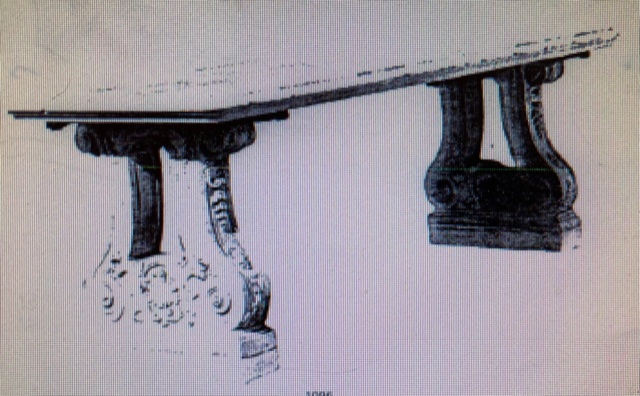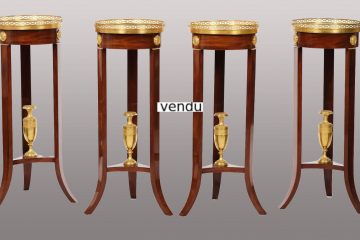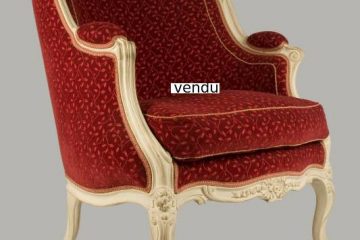
H: 0,78 m L: 2,80 m l: 1,05 m
Cette exceptionnelle table de forme rectangulaire repose sur deux pieds en marbre en forme de consoles inversées.
Les pieds reposent sur une plinthe. Evidés en leur centre et entièrement moulurés, les enroulements de la partie basse se terminent par une feuille d’acanthe suivie de fleurons, et de l’enroulement de la partie haute part une agrafe en console.
Vu de face les pieds sont entièrement moulurés. De part et d’autre de l’enroulement sont sculptés une feuille de lotus et des fleurons. L’enroulement bas s’écrase sur une feuille stylisée qui vient mourir sur la plinthe.
La bordure du plateau est soulignée par deux moulures suivies d’un bec de corbin et d’un cavet renversé.
Le marbre de Rance
Originaire de Belgique dans le Hainaut, l’approvisionnement en marbre « flamand » est à la fin du XVIIe siècle, un véritable tour de force dans un paysage déchiré par les guerres. Réputé pour être un édifice de marbres français et italiens, Versailles, fut surtout le terrain de jeu de marbriers originaires des Flandres. Les archives sont malheureusement presque inexistantes sur l’histoire de l’approvisionnement en marbre des Flandres, alors qu’elles sont très abondantes pour celle du marbre des Pyrénées et du Languedoc. La première génération de ces marbriers du roi originaires du Hainaut (Jean Le Grue, Jérôme Derbais, Hubert Misson et les huit frères Deschamps sont connus pour le commerce de Rance qu’ils menaient avec Derbais et Misson) déploya des trésors d’imagination pour acheminer ces marbres et en particulier le marbre de Rance afin de pourvoir aux décors du château. Il semble qu’une des premières livraisons faite par Misson et LeGrue fut celle des six colonnes destinées au baldaquin du Val-de-Grâce en 1664.
De tous les marbres flamands, le marbre de Rance fut sans nul doute le plus employé chez le Roi, et il fut acheminé en quantités très importantes. Tous les grands chantiers entre 1670 et 1690 employèrent le Rance: dans la cour de marbre et pour les pavillons du bosquet des dômes à l’extérieur, dans l’appartement des bains aménagé entre 1671 et 1680, dans les salons de la paix et de la guerre, dans l’escalier des ambassadeurs édifié entre 1672 et 1679, pour les pilastres de la galerie des glaces, pour la cheminée du salon de Diane, à l’intérieur.
« Jaspé » pour Mademoiselle de Scudéry, « blanc & rouge brun avec des veines blanches, cendrées & bleues » pour Dezallier d’Argenville, le marbre de Rance fut donc l’un des principaux ornements des grands appartements du Roi-Soleil.
Les tables de marbre dans les bosquets
A la même époque que Versailles, Le Nôtre crée des jardins tout aussi magiques au château de Chantilly ainsi qu’à Marly, et le journal de Dangeau montre l’intérêt du souverain pour cet art en se promenant parfois toute la journée dans les jardins de Trianon et de Marly. Ce dernier avait été qualifié par Louis XIV être le château pour ses amis, alors que Versailles avait été conçu pour la Cour et Trianon pour sa famille.
Il désirait que « rien ne manque de tout ce qui peut divertir les courtisans », à cet effet il multiplia les divertissements dans les jardins.
C’est ainsi que l’on peut voir une table ronde de marbre dans le bosquet du » vestibule de la table »(voir photo). Elle permettait aux invités de jouer aux jeux dit « de table » comme tric-trac ou échecs. Il en était de même dans le bosquet de Psyché.
Aux extrémités des deux salles de verdure qui se font face sont placés des bancs de menuiserie devant lesquels sont placés une table en marbre blanc à pans coupés de 7 pieds de long ( 2,26m). Ces deux tables sont commandées en 1707 à Solignon et décrites de la façon suivante: » les huit pieds de marbre blanc en consolles double ornées d’architecture et sculptés de 2 pieds ½ de hauteur ( 0,80m) compris le socle sur 17 pouces de large ». N’ayant pas obtenu la faveur royale, ces tables furent remisées dans les magasins.
Solignon et Montéant sculptent la même année seize autres pieds dont les huit à double consoles ornés de sculptures nécessaires à ces deux tables qui seront enfin installées dans le bosquet et y resteront jusqu’à la Révolution.
Dans le bosquet des Enfants (voir photo), le 23 juin 1701 Louis XIV inaugura un petit pavillon édifié en huit jours, on y plaça trois bancs de menuiserie peints en vert à filets dorés entourant une table de marbre vert Campan, posée sur trois pieds de marbre blanc « percé à jour » sculptés par Jacques Rousseau. Le 12 juin 1702, le Roi demanda » des couvertures de bois propres à toutes les tables de marbre du jardin pour les couvrir pendant les absences de Sa Majesté et pendant les hyvers ».
Après les châteaux de Marly, de Versailles, nous savons qu’une série de tables fut livrée par le marbrier du roi, Jean Cuvillier, en 1705. Elles ornaient le parterre bas du Grand Trianon et les pieds avaient été sculptés par Montéan et Harmand
Les marbriers
Les dépenses de marbre sont considérables sous le règne de Louis XIV, elles se chiffrent en millions de livres. Pour travailler ce noble matériau, une administration est mise en place, dépendant des Bâtiments du roi, sous la tutelle d’un surintendant (le duc d’Antin) et le contrôle des marbres sera assuré jusqu’en 1730 par Claude-Félix Tarlé.
Les marbriers travaillant pour la couronne s’intitulaient marbriers du roi, marbrier ordinaire du roi ou encore marbrier des bâtiments du roi .
Entre 1661 et 1717, neuf marbriers du roi sont recensés: Pierre Ménard, Mathieu et Hubert Misson, Jean et François Cuvillier, François Deschamps, Claude-Félix Tarlé, Antoine Cuvillier et Pierre Lisquy.
Nous retrouvons dans les archives un certain nombre d’artisans comme Dezègre, Pasquier, Ménard, etc…. jouant un rôle très important allant de l’extraction du marbre dans la carrière jusqu’au chantier auquel il est attribué. Dans l’inventaire après décès de Jean Cuvillier le 20 avril 1703, il est fait mention » d’une tranche de marbre de Rance de six pieds quatre pouces de long sur deux pieds quatre pouces de large et d’épaisseur deux pouces prisé vingt huit livres »
Les carnets d’expédition de Rance à la fin du XVIIIe siècle nous donne un très bon aperçu des expéditions. La plupart sont à destination de Paris et pour la plupart chez les marbriers, presque tous installés dans le quartier de Bonne Nouvelle et plus particulièrement dans la rue Poissonnière et cela dès la fin du XVIIe siècle.
Conclusion
Rôle politique, célébration de la monarchie, théâtre de la promenade quotidienne, les jardins sont aussi un espace de représentation pour les fêtes extraordinaires comme « les plaisirs de l’isle enchantée » en 1664 ou un décor pour les ballets. N’oublions pas que Louis XIV, danseur émérite, avait rédigé lui-même un opuscule sur la manière de montrer les jardins de Versailles et qu’il donnait des ordres très précis quant à l’ordonnancement des plantations et de la décoration des bosquets. Ils étaient l’endroit privilégié pour servir les collations, comme ce fut le cas au bosquet de l’Etoile lors du » grand divertissement royal » en juillet 1668, événement gravé par Le Pautre.
Cette production de tables de marbre, très coûteuse semble être spécifique à l’époque Louis XIV et cette table fait partie des livraisons pour les bosquets de Versailles ou de Marly. Comme nous avons pu le voir précédemment, les descriptions ne sont pas assez précises pour identifier l’endroit exact où elle se trouvait.
La table conservée au musée de la chasse prouve que ce type de meuble était fabriqué à plusieurs exemplaires pour orner un même bosquet.
Deux tables de marbre blanc étaient visibles au début du 20e siècle au Grand Trianon (voir photo), après avoir été installées dans les jardins du pavillon de La Lanterne, elles ont aujourd’hui réintégré les jardins du château de Versailles.
Ancienne collection Cécile Sorel dans son appartement Quai Voltaire. Dans un article de l’Illustration par Jacques de Baschet, il est dit que « la table vient du Palais de Trianon, enlevée du vestibule où deux autres tables semblables figuraient encore au temps de pillages de la Révolution, sans doute ». (voir photo)
Enfin, une table identique à la nôtre est conservée au musée de la chasse- Hôtel de Guénégaud – Paris – Ancienne collection Sommer (voir photo)










